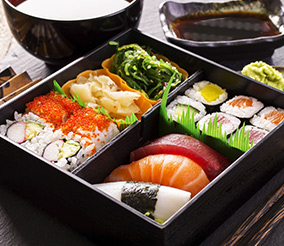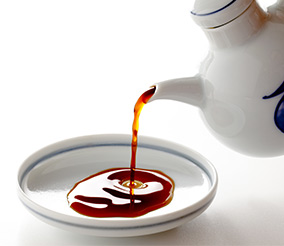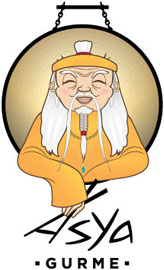Cuisines
(Japanese)

Bento Box

Soy Sauce Service
If you asked the first person you came across about the Japanese food, you are most likely to get ‘sushi’ as an answer. On the contrary to the common belief, sushi is not consumed very often in the daily Japanese experience.
Japanese Cuisine is pretty much the healthiest kitchen one can encounter. In traditional Japanese cooking, oil and spices are used moderately. The additives that would overpower the essential flavors of the main ingredients are avoided and most of the cooking is performed in a rapid fashion to save the nutrition value.
Portions served are usually small and tended to have a pleasing presentation. Paying attention to the least significant details and serving in the most artistic manner are very essential. So cutting and/or slicing, color, balance and harmony in presentation are very important. Vegetables are classified as green, red, yellow, white and black-purple according to the color. Soy sauce, mirin, dashi, and ‘Sake’ are the main ingredients in most of the recipes. There is no wonder why the Japanese are not overweight in general sence, since there is almost no desert in traditional Japanese cuisine, so it’s tea what is generally served after the meal. Green tea is largely consumed through all country. The traditional Japanese liquor, Sake, is produced from rice and cereal powders and is served warm as well as cold.
Japan had been introduced to soy, soy sauce, tofu and chopsticks, and learned rice farming with the influence of Chinese around 300 BC. In the early 1200’s, corn and potatoes were introduced to Japanese cuisine by way from west.
In Japan, being a country of chain of islands and very rich in sea food as a wetland, and also meat being considered disgraceful and prohibited to consume for several centuries, seafood was the main part of the traditional cuisine for a long period of time.
It was not until with the influence of Chinese, Portugese and Indian cuisines that Japanese were introduced to meat. Curry, also had found its place in Japanese cooking with the influence from India. Japanese curry, known as ‘kare’, is being used for centuries.
Soup as a Japanese Culinary Classic
Essentials of the Japanese cuisine are the rice, seaweed and soup. The most famous of the soups, ‘Miso’, is prepared with some sort of soybean paste. Soups are generally prepared with fish broth called ‘dashi’, vegetables, meat, tofu and noodles. Ramen soup, which is a noodle dish, is very favorite. Traditional presentation of the soup is in bowls with lids called ‘owan’. The solid ingredients of the soup are eaten by the chopsticks and the liquid part is drunk straight from the bowl.
Rice and Noodle
Rice is in almost every meal. The food that accompanies rice is called ‘okazu’. Noodle being the second most consumed food is also commonly used in soups and slops. Main kinds of noodles are the udon, the ramen, and the soba.
Udon is usually made from wheat. It is thick and large and is used mostly in soups and slops.
Ramen, also made from wheat flour but thinner, is used mostly in soups and salads.
Soba is made from buckwheat flour and as thin as angel’s hair, is generally served as a cold dish in summer.
Japanese Chopsticks
In Japan, the chopsticks are called ‘hashi’ and used in various meanings. The chopsticks used for cooking are different in length from the ones that are being used for eating. The sticks stuck up in the food symbolize the death and could only be seen in a wake. There are also types of sticks which were designed merely to be used in tea ceremonies or serving for deserts.
The chopsticks are made mostly up of bamboo, wood, plastic, bone, metal and less likely of ivory to be used in special occasions. Japanese chopsticks are shorter then Chinese and longer then the Korean ones. ‘Hashi’ are more colorful, decorative and uniquely designed comparing the neighbours’ utensils. They are generally lacquered in bright colors and pointy towards to the end. The sizes of the sticks varies within the family use. The children use the smaller size and adult males use the longest while women use a moderately long sticks.
On table set ups, the sticks are placed horizontally in front of the bowl with tips pointing to the left.
Keywords
Teppanyaki
Any kind of meat, vegetable, or noodle grilled on sheet iron
Yakiniku (Japanese Barbeque)
A thinly sliced meat (mostly veal) or vegetable dish cooked on an electric or gas grill that is mounted in the center of the banquette
Shabu-shabu
Thinly sliced meat or vegetables stewed in boiling water
Tempura
A dish of all kinds of deep fried meat or vegetables. Nibbles should be covered thoroughly with thick and starchy Tempura batter. A not very well known fact about Tempura is that of its origins are Portuguese.
Yakitori (Skewers)
All kinds of grilled meat (especially chicken), and veggies on skewers
Kobe Beef
A very special kind of dry aged beef. The calves are treated and massaged meticulously in order to obtain this tender meat
Bento Box
Bentos are Japanese lunch boxes which are used in restaurants, and homes, as well as for the take outs. ‘Take Out’s are very commonly consumed in Japan. A bento contains a different compartment for each dish of rice, meat, and veggies.

